Canon’s 16-35mm f2.8L II - Is it worth the money?
Text and photography copyright © Darwin Wiggett. All rights reserved.
First, I am biased. Second, I do not have a testing lab or even the knowledge to give precision optical lens tests. Third, I really only care how a lens performs in the field. And finally, differences are only important to me if they truly affect the end result – e.g. can I see differences in prints bigger than 16x20 inches?
My bias? I am not a big fan of wide-angle zoom lenses because in the past, they tended to be less sharp, more prone to flare, did not focus as close, had distortion, and vignetted with filters more than fixed wide-angle lenses. Every wide-angle zoom I ever tested suffered from these problems and the original Canon EF 16-35L was no exception. So, I was mostly a fixed wide-angle lens user.
A few years ago, Canon introduced the 17-40 f4L and it actually was reported to be sharper, with less flare and distortion than its 16-35L counterpart. This inexpensive lens has become a favorite among many Canon shooters and got solid reviews. I picked up the 17-40 about a year ago and found it to be a decent performer as long as used properly (more on this below). It earned a place in my bag as an all-around hiking lens.
When Canon introduced the new version of the 16-35L, it was heralded by many on the web as a great improvement and a ‘highly recommended’ buy. I grabbed one from the local camera store and tested it against my 17-40L and my 24mm TSE lens. I had high expectations from this newly engineered wide zoom.
The Results
I used a tripod with mirror lock-up and live view for precision manual focus using my EOS-1ds Mark III with all lenses tested. I photographed scenes in all sorts of light and at all apertures.
Here is a summary of what I found:
All of the lenses performed very well for center sharpness at apertures from wide open (f2.8 and f4) all the way to f16. Stopped down past f16 all three lenses suffered a great loss of resolution and were less sharp at f22 than at f2.8 or f4! Sharpness is so bad at f22 with all the lenses that I will never use that aperture again! The sharpest apertures on all three lenses were f8 to f11. In the end, I could not see any differences in center sharpness between the two wide-angle zooms and the 24mm TSE.
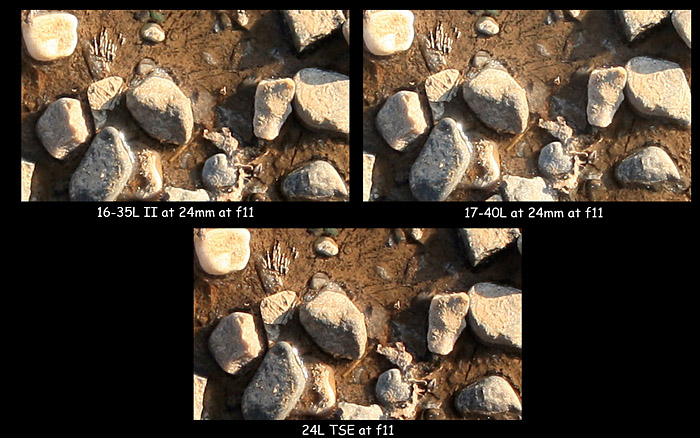
Where significant differences in sharpness really showed up was at the edges of the frame. I am using a full frame camera and both zooms really have poor edge-to-edge sharpness. At f2.8 and f4 sharpness looks more like a lens baby than an L-lens! See the photo below for an example.
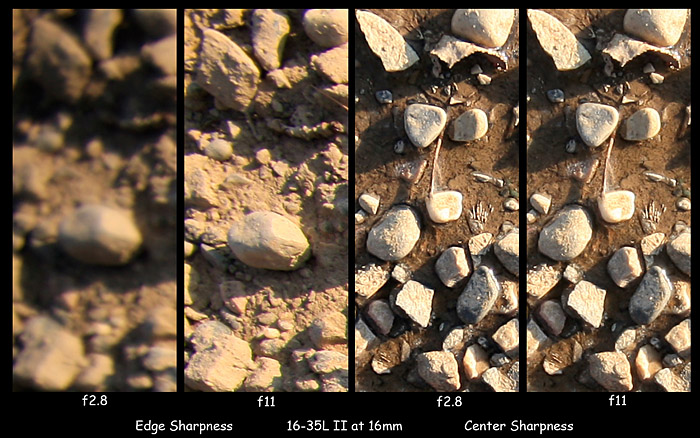
When I compared the edge sharpness of the 16-35 L II with the 17-40L, I really could not see much of a difference. The 17-40L was a little sharper on the edges at 17 and 24mm but the 16-35L II was better at 35mm. These differences, although small, were obvious at 100% in Photoshop. But in enlargements up to 20 by 30 inches I really could not detect any differences in edge sharpness between the two lenses. In numerous other tests I have seen on the web, the 17-40L and the 16-35L II are essentially of equal sharpness. My testing confirms this general conclusion. So sharpness alone is not the reason to buy the 16-35L II.
As an aside, the 24mm TSE is sharper edge-to-edge than either zoom lens. This is not surprising given that the image circle of the 24mm TSE is larger than the sensor to allow for shift and tilts. When edge-to-edge sharpness is critical for me, I switch to the 24TSE.
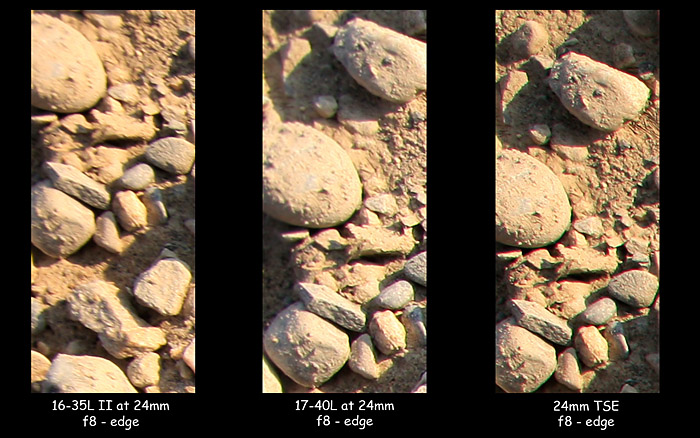
One area where the 16-35L II outperformed the 17-40L was in contrast. The 16-35mm lens is a bit ‘snappier’ than the 17-40L (see photo below). Both seem to have equal amounts of flare and fringing, though. I did notice that at f4 and f5.6, the 16-35mm had more even exposure across the frame than the 17-40L.
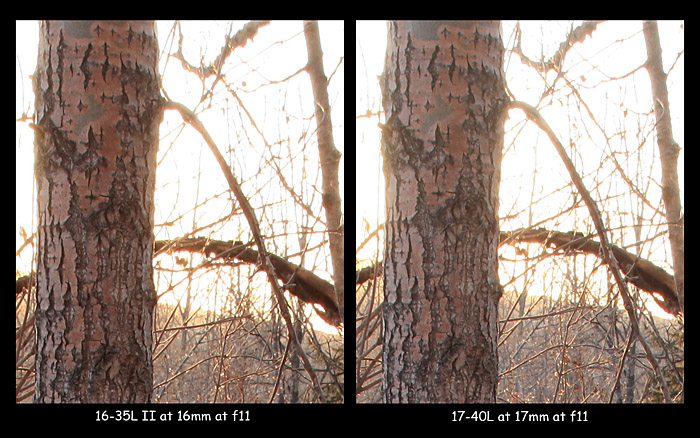
As far as distortion control, both lenses suffer in that department (photo below) and I really could not tell if one had more distortion than the other. Notice in the 17-40L photo that there is a bit a flare showing up in the lower right corner of the photo. Flare is a problem with both lenses and both have their weak focal lengths for flare. My 24mm TSE rarely suffers from serious flare unless rigorously tilted with the sun in the frame.

The Conclusion
The advantages of the 16-35L II are subtle. The lens has a faster aperture and so the viewfinder will be brighter for focusing (always a good thing). The fast aperture might be useful for sports and action photographers and center performance is great at f2.8. But edge softness is so bad on a full frame camera that I would be hesitant to use this aperture unless the subject is dead center.
The 16-35L II also has more even edge-to-edge exposure, better contrast, and snap at wide apertures and at some focal lengths, slightly better flare control.
For me as a landscape photographer, the disadvantages of the 16-35 II lens far outweigh any slight advantage the lens may have. The 16-35L II is twice the price of the 17-40L, it weighs in at almost 150g more, and it has a large front element requiring special order 82mm threaded filters. And finally, in terms of real world performance, I just can't see any differences between the two lenses, so I see no reason to opt for the heavier more expensive lens.
Both of these wide-angle zooms are finicky on full frame cameras and to get acceptable edge performance with good depth-of-field, these lenses should be shot at f11 to f16, maximum. I almost always use my 17-40L at these apertures and if I need more depth-of-field than f11 to f16 will give me; I often take two photos, one for foreground sharpness and one for background sharpness and blend the two photos in Photoshop (see photo below).
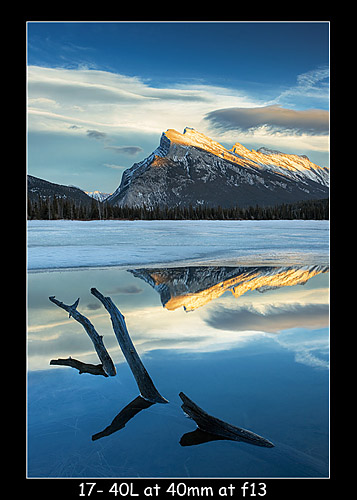
But I admit, as often as possible, I turn to my 24mm TSE for landscape photography because I can tilt for max DOF and use f8 or f11 for optimal resolution. The results from a tilted 24mm always blow away the 16-35L II and the 17-40L lenses in terms of sharpness. When I need something wider than my 24mm TSE will give me I pull out my 17-40L.
As a final note, anyone using a 1.3 or 1.6 crop camera will find either of these wide-angle zooms to be remarkable performers because the whole issue of edge sharpness is eliminated.
Comments on NPN digital photography articles? Send them to the editor.
Darwin Wiggett is a professional nature and outdoor photographer from Alberta, Canada. You can see more of his work at www.darwinwiggett.com or at www.timecatcher.com.


| 


